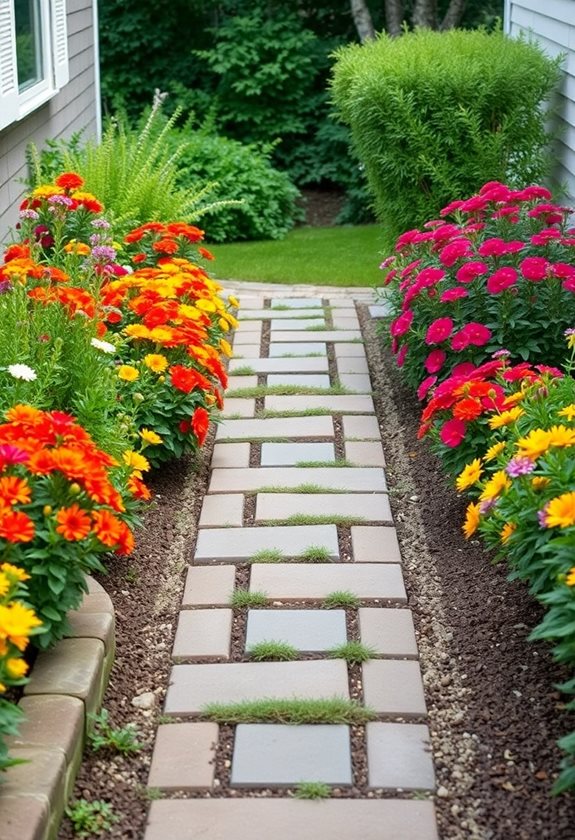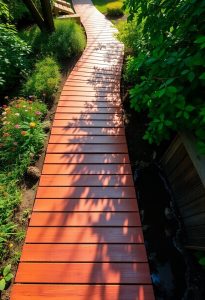Planning efficient straight garden paths in small spaces can really amp up your garden game! Start by measuring your area so you don’t overcrowd it. Choose materials like gravel for drainage or pavers for style. Use stakes and string to outline your path, aiming for about 3 feet wide—enough room to stroll! Don’t forget to sprinkle some favorite plants along the sides for a pop of color and fragrance! Curious about more tips? There’s plenty more to explore!
Design Highlights
- Measure the space to ensure the path doesn’t overcrowd the area while allowing for easy movement.
- Choose durable materials like gravel or pavers that complement your garden’s style and withstand weather conditions.
- Plan a straight path layout using stakes and string for clear outlining and a neat appearance.
- Aim for a width of 3 feet for comfortable strolling and ensure easy access for maintenance tasks.
- Incorporate low-growing plants or ground covers along the path to enhance visual appeal without obstructing movement.
Assessing Your Space and Needs
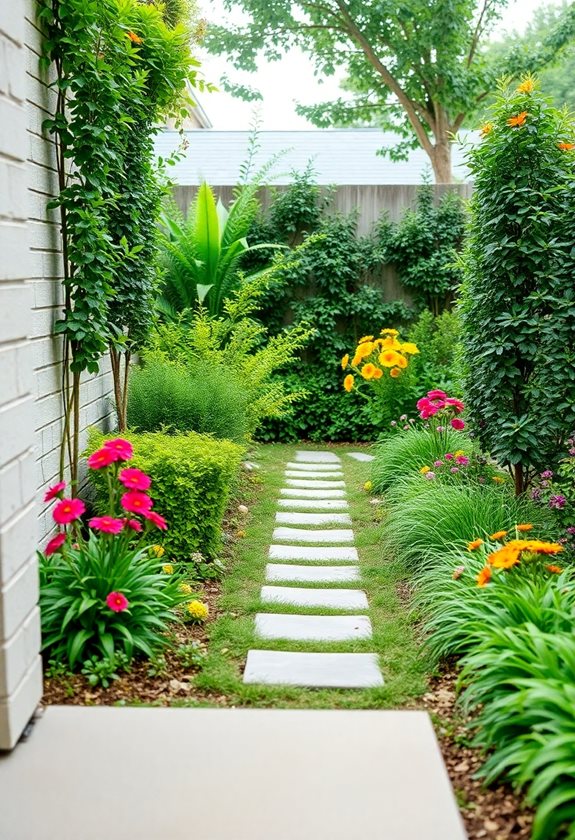
When you’re ready to plunge into planning those garden paths, it’s essential to really assess your space and needs first—after all, a well-thought-out path can transform a cramped backyard into a cozy oasis! Start by measuring your area; you don’t want to design a winding path that takes up all your space! Consider how you’ll use the path. Will it lead to a seating area, or connect flower beds? Think about maintenance, too—can you easily navigate to tend your plants? Trust me, a little planning now saves headaches later. Material durability is also a crucial factor, as it affects the longevity and upkeep of your garden pathways. Ready to dig in? Your garden awaits!
Choosing the Right Materials
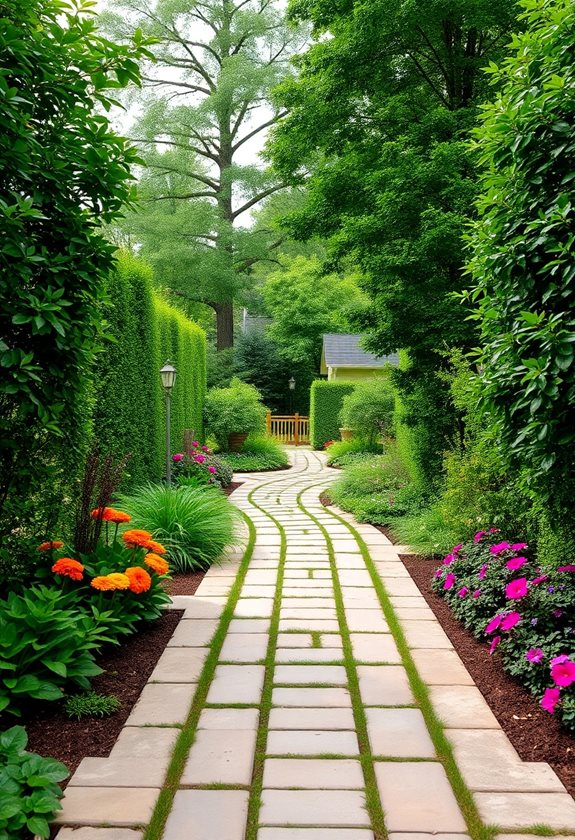
Choosing the right materials for your garden path can feel like a challenging task, especially with so many options out there! You’ll want materials that suit your style and withstand the elements. Think about:
Selecting materials for your garden path can be overwhelming, but it’s essential to find options that match your aesthetic and weather durability.
- Gravel: It’s affordable and great for drainage!
- Pavers: Perfect for a polished look, but a bit pricier.
- Wood chips: Eco-friendly and cozy, but may decompose over time. Additionally, using high-quality cedar ensures durability against weathering and fading.
Designing the Path Layout
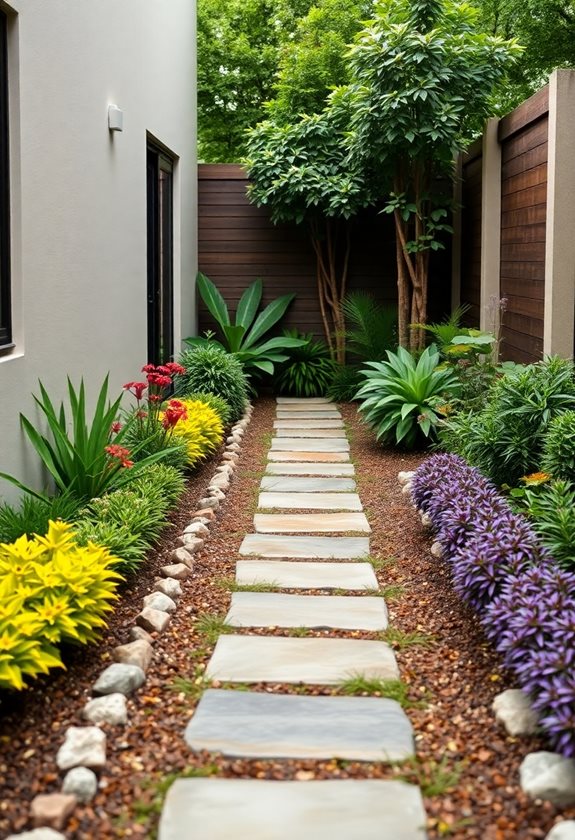
As you plunge into designing your garden path layout, you might feel a mix of excitement and a hint of overwhelm—after all, a well-planned path can transform your small space into a cozy retreat! Start by visualizing the flow: where do you want guests to wander? Consider these tips:
- Keep it Straight: Straight paths look neat and guide visitors effortlessly.
- Measure Wisely: Use stakes and string to outline your design.
- Balance Width: Aim for about 3 feet wide—enough for two to stroll comfortably. Additionally, consider incorporating pathway lighting ideas to enhance the ambiance and safety of your garden paths in the evenings.
Incorporating Plant Life Along the Path
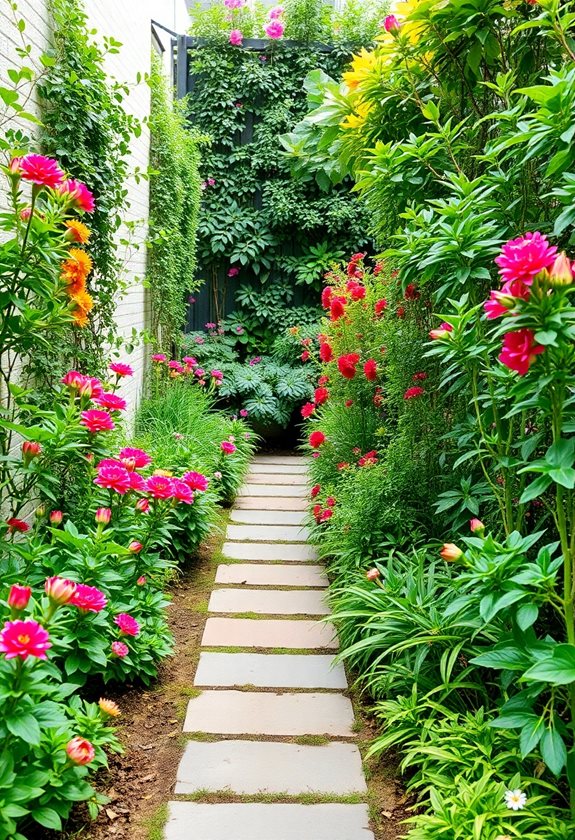
You’ve mapped out your path, and now it’s time to bring it to life with vibrant plant life! Think of it as adding a splash of color to your canvas. Consider these ideas to enhance your garden path:
- Low-growing ground covers: They’ll create a lush look without blocking your path.
- Fragrant herbs: They’ll not only smell amazing but also add a culinary twist!
- Colorful annuals: They’ll offer seasonal blooms for continuous interest.
- Dramatic perennials: They’ll provide structure and depth throughout the year. Additionally, incorporating edible plants can transform your garden into a beautiful and flavorful oasis!
Maintenance Tips for Long-Lasting Paths
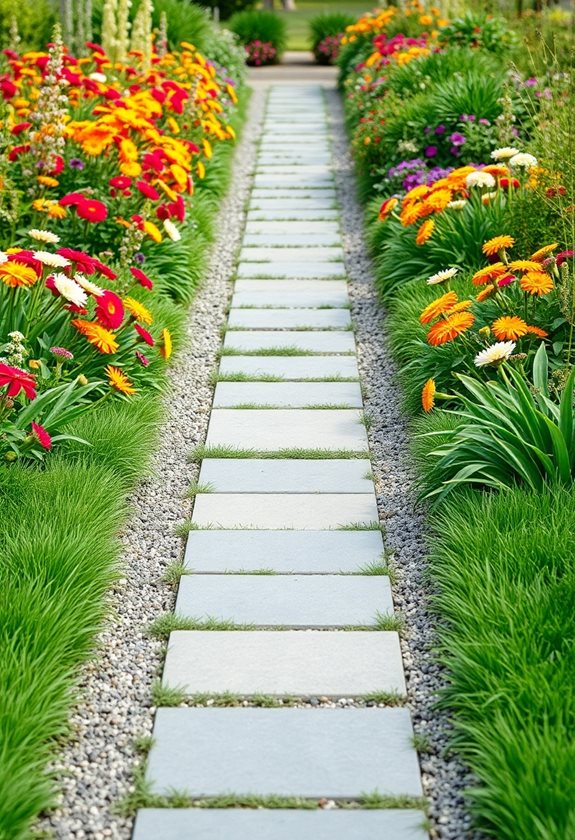
While creating a beautiful garden path is rewarding, keeping it looking great over time can feel a bit like a never-ending chore, right? To maintain your path’s charm, try these tips:
- Regularly sweep away debris to prevent stains and moss.
- Inspect joints for weeds—pull them out before they take over!
- Wash stones or pavers with a gentle soap solution to keep colors vibrant.
- Seal surfaces every couple of years to protect against wear. Additionally, consider incorporating pathway lighting options to enhance both safety and aesthetics during nighttime.
Frequently Asked Questions
What Are the Best Plants for Narrow Garden Paths?
When you’re choosing plants for narrow garden paths, think about low-growing, hardy varieties. They’ll keep your pathways clear while adding beauty! Consider options like:
- Creeping thyme: It smells amazing and blooms beautifully.
- Miniature sedums: They’re tough and vibrant.
- Irish moss: Soft and cushiony underfoot!
These plants won’t overgrow and will make your paths feel inviting. Plus, they’ll thrive with minimal maintenance. Isn’t it fun to create a garden that’s both practical and pretty?
How Wide Should a Garden Path Be for Walking?
When you’re thinking about your garden path, aim for a width of at least 24 inches. This gives you enough space to walk comfortably without feeling cramped. If you’re planning to carry tools or supplies, 36 inches is even better! Picture yourself strolling through your garden, taking in the beauty around you. Isn’t that a lovely thought? Just remember, a well-planned path can make all the difference in your gardening experience!
Can I Use Recycled Materials for My Garden Path?
Absolutely, you can use recycled materials for your garden path! It’s a fantastic way to save money and be eco-friendly. Think about using old bricks, broken concrete, or even reclaimed wood. Just make sure they’re safe and sturdy. You’ll not only create a unique look but also share your gardening journey with the planet. Ever tried a path with colorful tiles? It’s a fun way to express your creativity while recycling!
What Is the Best Way to Prevent Weeds in Paths?
To keep those pesky weeds at bay, you’ve got a few solid options! First, consider using mulch; it not only looks great but also suffocates weeds. You can also lay down landscape fabric before installing your path—it’s like a bouncer for your garden! Regular maintenance helps too; a quick weeding session can save you a lot of trouble later. So, what’s stopping you? Grab your tools and tackle those weeds today!
How Do I Create a Path That Accommodates Wheelchairs?
Creating a wheelchair-friendly path is essential for accessibility! Start by ensuring your path is at least 36 inches wide, so there’s plenty of room to maneuver. Use smooth materials like pavers or gravel, avoiding anything too bumpy. Don’t forget to include gentle slopes instead of steep inclines. Have you thought about adding edges to prevent erosion? And hey, why not plant some colorful flowers along the sides for a beautiful touch? Happy gardening!

